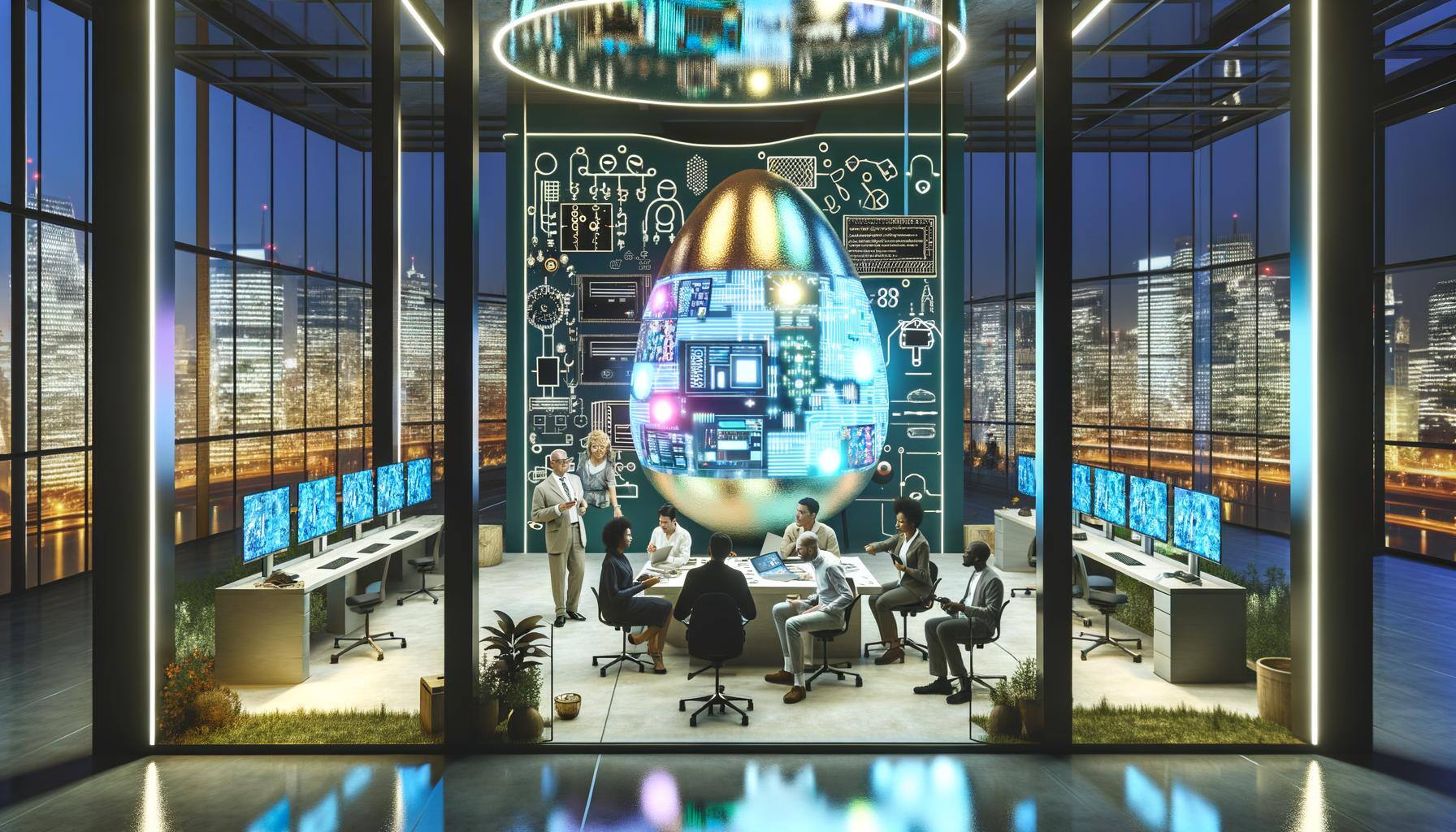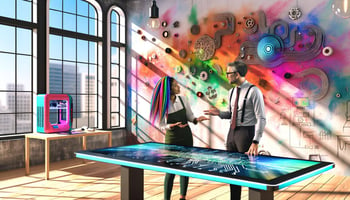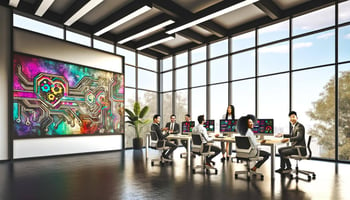Harnessing IT as Art for Business Innovation
Exploring IT as an Art Form: Innovation Beyond Logic

Rethinking IT: From Technical Precision to Artistic Expression
In the ever-evolving landscape of information technology, a transformative shift is underway. Traditionally dominated by logic, precision, and functionality, IT is now being reimagined as a vibrant art form that embraces creativity, intuition, and aesthetic expression. This revolutionary perspective challenges the conventional view of technology as merely technical and opens up new avenues for innovation and engagement.
At the heart of this transformation is the idea that technology is not just a collection of tools and processes but a medium through which human creativity can be expressed and experienced. This artistic approach allows IT professionals to explore new dimensions, driven by emotion and intuition alongside logic and function. By embracing this perspective, solutions can be crafted that are not only efficient but also engaging and resonant on a deeper level.
Advocates of this view argue that IT's potential to tell stories and evoke emotions is akin to traditional art forms like painting or music. This shift in perception redefines how we interact with and perceive technology, fostering a deeper connection with digital innovations. As IT continues to evolve, integrating artistic elements promises to enrich and expand the possibilities of what technology can achieve.
The Creative Intersection: Where Art Meets Technology
The convergence of creativity and technology in IT is not entirely new but has gained renewed interest with the rise of digital art, virtual reality, and other groundbreaking advancements. This intersection allows for the creation of immersive experiences that captivate users in ways previously unimaginable. By leveraging design, color, and storytelling, IT professionals can produce products that are not only functional but also aesthetically pleasing and emotionally engaging.
One of the key strengths of viewing IT as an art form is the potential for innovation it unlocks. When creativity is prioritized, breakthrough solutions can emerge, challenging conventional wisdom and introducing new paradigms. This creative approach also fosters a more inclusive environment in technology, inviting diverse perspectives and ideas that might otherwise be overlooked in a purely technical context.
However, this creative synergy is not without challenges. It requires a delicate balance between artistic freedom and technical constraints. While creativity can drive innovation, it must be tempered with the practicalities of implementation and scalability. Finding this balance is crucial to ensuring technological solutions are both imaginative and viable, allowing for artistic exploration without compromising technical precision.
Unlocking Innovation Through Artistic Perspectives in IT
Viewing IT through an artistic lens offers several compelling benefits, chief among them the potential for enhanced user engagement. Products that incorporate artistic elements tend to stand out in a crowded digital landscape, capturing the attention and imagination of users. This engagement is not only beneficial for attracting users but also for retaining them, as aesthetically pleasing and emotionally resonant products often foster stronger connections.
Furthermore, treating IT as an art form encourages experimentation and risk-taking, which can lead to groundbreaking innovations. When creativity is given free rein, it can inspire novel approaches to problem-solving that might not emerge in a strictly technical environment. This openness to experimentation can also foster a culture of continuous learning and adaptation, essential in the fast-paced world of technology.
However, the strengths of this approach must be weighed against potential drawbacks. Critics caution that an overemphasis on artistic expression could overshadow the technical aspects of IT, leading to challenges in delivering reliable and efficient solutions. This highlights the need for a balanced approach that integrates both artistic and technical considerations, ensuring that innovations are both creative and practical.
Intuition and Instinct: The Invisible Forces Driving IT Creativity
Intuition and instinct play a crucial role in the artistic approach to IT, guiding decisions that may not be immediately evident through data or logic. This intuitive process allows IT professionals to tap into their creative instincts, leading to solutions that are innovative and unexpected. By trusting their gut feelings, they can explore new possibilities and take risks that might not be considered in a more analytical framework.
However, relying on intuition in IT is not without its risks. It requires a deep understanding of both the technology and the creative process to ensure that instinctive decisions are informed and effective. Without this foundation, there is a danger of pursuing ideas that are not feasible or aligned with project goals.
Despite these challenges, intuition remains a valuable tool in the IT-art paradigm, offering a path to creative breakthroughs and unique solutions. By embracing intuition, IT professionals can unlock new dimensions of innovation that go beyond the limitations of data-driven decision-making, fostering a culture of creativity and exploration.
Historical Roots: The Evolution of Art and Technology Collaboration
The relationship between art and technology has deep historical roots, with each shaping the development of the other throughout history. From the invention of the printing press to the birth of cinema, technological advancements have consistently transformed artistic expression. Similarly, artistic movements have inspired technological innovations, pushing the boundaries of what is possible.
In the 20th century, the rise of digital art and computer-generated imagery marked a significant turning point in this relationship. Artists began to explore the creative potential of technology, using computers as both a tool and a medium for their work. This era saw the emergence of digital artists who blurred the lines between art and technology, creating works that were both technically complex and artistically compelling.
Today, this historical interplay continues to evolve, with IT professionals increasingly embracing the artistic dimensions of their work. By drawing on the rich history of art and technology, they create products and experiences that resonate with users on both a functional and emotional level. This ongoing collaboration highlights the transformative power of integrating art and technology, offering a glimpse into the future potential of IT as an artistic movement.
Overcoming Challenges in the IT-Art Convergence
Despite its potential benefits, the notion of IT as an art form faces several challenges and criticisms. One of the primary concerns is the risk of compromising technical precision in favor of artistic expression. Critics argue that while creativity is important, it should not come at the expense of functionality and reliability, which are critical in IT.
Additionally, there is a concern that the artistic perspective might not always align with business objectives. In a corporate setting, where the focus is often on efficiency and profitability, the artistic approach may be seen as impractical or unnecessary. This can lead to tensions between IT professionals who embrace the artistic paradigm and stakeholders who prioritize traditional metrics of success.
Moreover, the subjective nature of art can lead to differing interpretations and expectations, potentially complicating collaboration and communication within teams. It requires a shared understanding and appreciation of both the artistic and technical aspects to ensure that projects align with overall goals. These challenges highlight the importance of finding a balance between creativity and practicality in the IT-art convergence.
Visionary Innovators: Pioneers Blending Art and IT
Throughout the history of IT, there are numerous examples of innovators who have embraced the artistic dimensions of their work. Figures like Steve Jobs and Jony Ive at Apple famously prioritized design and aesthetics, leading to products that were both functional and visually stunning. Their approach demonstrated the power of integrating art and technology to create products that resonate with users on an emotional level.
Similarly, digital artists and programmers have pushed the boundaries of what is possible in the realm of IT, creating immersive virtual worlds and interactive experiences that captivate audiences. These pioneers illustrate the potential of viewing IT as an art form, showing that creativity and technical expertise can coexist and complement each other.
These stories serve as inspiration for those who advocate for the IT-art paradigm, highlighting the transformative impact of blending creativity with technology. They demonstrate that when IT is treated as an art form, it can lead to innovations that not only solve problems but also enrich our lives, offering new possibilities for engagement and connection.
Future Prospects: IT as a New Paradigm of Artistic Movement
As the boundaries between art and technology continue to blur, the future prospects for IT as an artistic movement are both exciting and uncertain. The rapid pace of technological advancement offers endless possibilities for creative expression, from virtual reality and AI-driven art to interactive installations and beyond. This convergence of art and technology promises to redefine the role of IT in society, transforming it from a purely functional discipline to a source of inspiration and creativity.
Yet, the success of this movement depends on the ability to balance artistic expression with technical rigor. As IT professionals explore the artistic dimensions of their work, they must also ensure that their creations meet the practical needs of users and stakeholders. This requires a collaborative approach that values both creativity and functionality, fostering an environment where innovation can thrive.
Ultimately, the future of IT as an artistic movement lies in the hands of those who dare to challenge conventions and push the boundaries of what is possible. By embracing the artistic potential of technology, they can create a new paradigm that enriches our digital world and inspires future generations of IT innovators.



